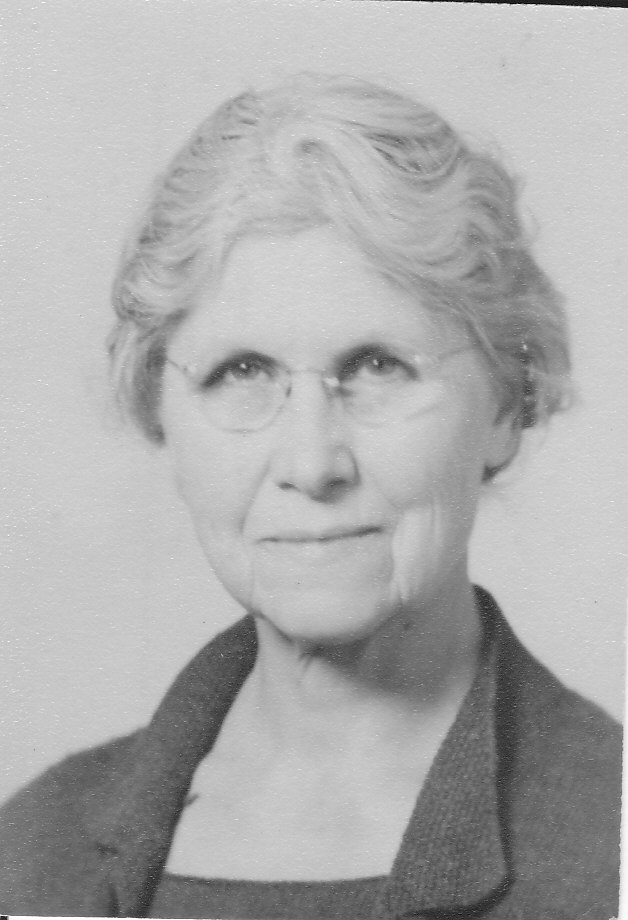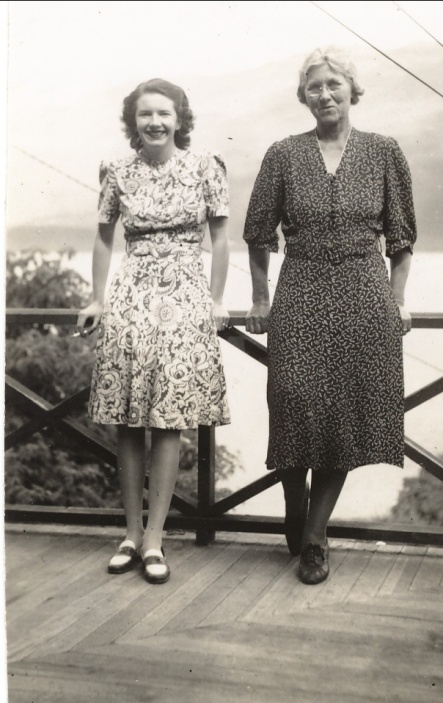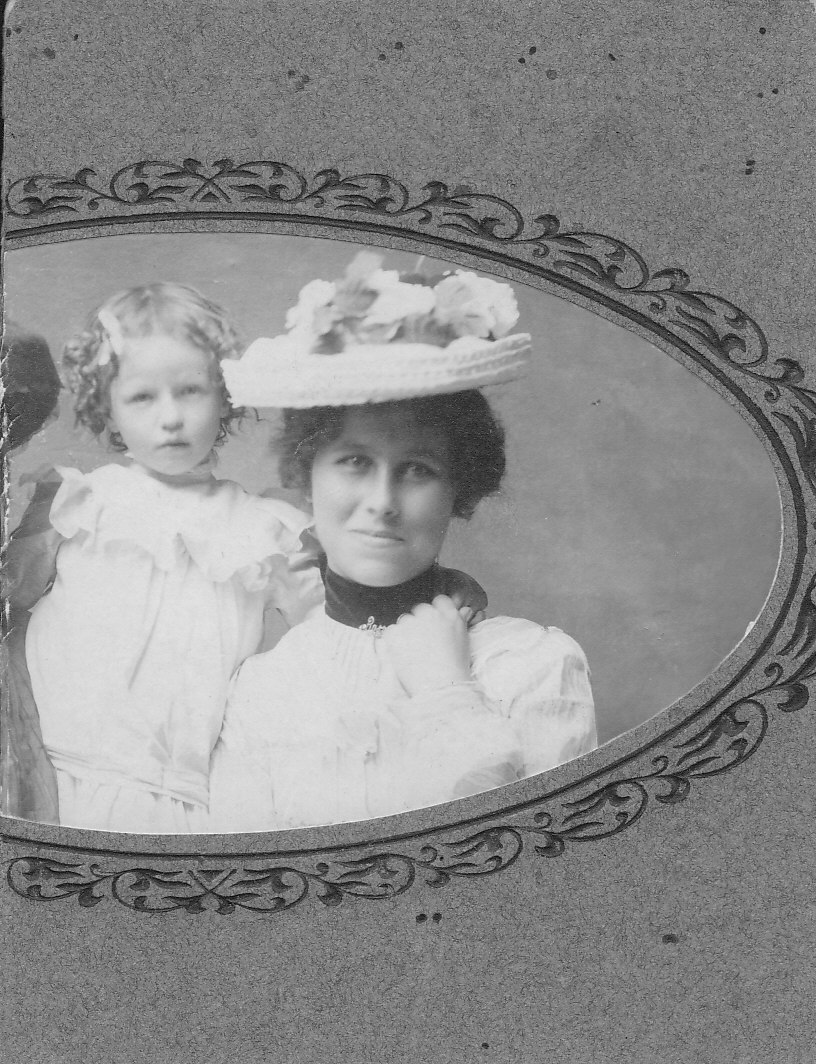Rose Yvonne Swain – Grandma Rose was born 28 November 1882? Near Prince Albert, Saskatchewan. She died on Oct. 10, 1964 in Nelson, BC from cirrhosis of the liver. She was buried on October 15, 1964 in Nelson
Rose’s birth certificate says she was born Nov. 28, 1883 at Prince Albert. This was information that she provided the Saskatchewan government in 1941 when she applied for a birth certificate. She couldn’t locate her baptismal record (I have looked unsuccessfully in every nook and cranny for it). Her cousin Panteleon Schmidt was her informant. She was probably born earlier. Her Mother married Rose’s stepfather 10.5 months before the listed Nov. birth date. When her mother married Elzear Swain, the marriage register shows her name as Caroline Schmidt so Caroline never married Ralph Nome who was Rose’s father. It was probably more convenient for Rose to give her birth date 10 months after her mother married.(There are several other mistakes on her birth certificate other than the name of her father and the listed birth date: her stepfather Elzear was not born in England but in Manitoba,. It says children alive of this mother were Edmund and Rose. Rose’s mother married Elzar in St. Laurent not Prince Albert). As for where she was born, John Mc Nab Ballendin McKay was a witness on her Scrip application. He says he was a neighbour when she was born. He homesteaded at River Lot Township 46 Range 26 W2 which is some 25 km SE of Prince Albert. Rose never knew her father or his parents. She probably didn’t know her maternal grandmother either as he was estranged from the family. However she lived in the same area as her maternal grandmother and some of her aunts and uncles so she had some family around. The Schmidt relatives called her Yvonne because there were three other Roses.
Not much is known of her early years.
She was only three at the time of the Rebellion at Batoche but her family was affected .Her grandfather Alfred, his wife Emelei and four children were taken prisoner when Fort Pitt surrendered and were held six weeks by Big Bear. Her uncle Modeste was a member of the Battleford Rifles fighting for the rebels. Meanwhile her stepfather and brother John were on the opposite side. Elzear was charged with treason and held for four months in Regina before being released. Elzear’s brother John was killed at the Battle of Batoche and buried sitting up in a mass grave (Indian style). Her stepfather claimed land at Pt 2 & 9 Township 45 Range 27 in 1883. This is near St. Louis, SK. In 1891 they were living in St. Laurent, SK. In 1891 her stepfather is listed as a farmer. In 1901 he is listed as a hunter.
In 1900 they were living in Havre, Montana where they went about 1898. Eight of her step siblings were going to the Fort Shaw Indian Residential School there. Fort Shaw was considered “The Queen of Montana Posts” and was used as an Indian School after being abandoned in 1890. She had 10 step siblings. A number of Canadian Cree together with a small band of Chippewa’s from the Great lakes area lived a semi nomadic life in this area. For many years they moved between Montana cities such as Butte, Helena, Great Falls and Havre and in and out of Canada. They tried to obtain a reservation but were unsuccessful as they and their leader – Little Bear- were considered Canadians. The U.S. government tried unsuccessfully to deport them in 1896. Eventually they joined up with Chief Rock Boy and obtained the Rocky Boy reservation south of Havre in 1916. In 1900 and received Scrip as a Métis. In 1901 they were living in East End, SK. In the 1901 census she is listed as speaking French and English but her mother tongue is Cree and her racial origin is Cree SB (Cree Scotch Breed). Years later as a senior she still remembered many Cree words and prayed in French. She was devout Catholic and went to Mass daily for many years. Rose remembered travelling across the prairies by Red River cart and using buffalo dung as fuel.
In 1906 she was censused at the Commercial Hotel in Maple Creek, SK working as a waitress. Her mother and siblings were also there. When Rose and John Burns were married in Nelson, the Daily News said she was from Lethbridge. She told me she had lived in the Milk River Country in Southern Alberta .Her engagement notice calls her Rosie, popular local girl.
Rose arrived in Nelson about 1908. One of her sisters travelled with her settled in Ymir where she worked at the hotel. She died in the Spanish Flu epidemic of 1918/19 and is buried in Ymir. Both Cousin John and Dad and I have searched for her grave several times but there is no marker. Rose was working as a waitress in the Hume when she met her husband to be.
She married John twice. The first time was at the Anglican Church (a compromise between Catholic and Presbyterian?) then six weeks later in the Catholic Church.

She enjoyed life as they became relatively prosperous. They had a nice home in town and a summer home on the North Shore. She could afford shopping trips to Spokane. It was said that if she wanted a piece of furniture badly enough, she would talk her husband into buying the house furnished. She enjoyed gardening and had a lovely flower garden at the summer home in Nelson as well as nice flowering gardens around the Ainsworth pool and hotel. She also had a big vegetable garden at their Ainsworth summer home along with fruit and berries. Rose learned to swim with her children at age 40 and learned to drive a car in her late 40’s. She was an expert seamstress and even made hats. She also loved music, dancing and reading. After her children were grown, she and John spent part of the winters in Vancouver. She took her daughter Jean to Saskatchewan to meet her relatives in 1917.
When John and Rose lived across the lake from Nelson, there was boat access only. They had boathouses on both sides of the lake and John kept a garage on the Nelson side. They had a variety of small boats – some with inboard motors, some were rowboats made at Walton boat works. The rowboats were beautiful and easy to row. They used to go over for the summer around April or May but would sometimes go earlier for a few days to get things ready. Gram loved these times and liked to make her tea from a spring on the property that was near a salt lick used by the deer. Rose was an outdoor woman long before the term became popular. She was not much for cooking and cleaning but she loved to hike. She often took the steep hike up to the reservoir ( the water supply which was a dammed spring up the mountain)or Pulpit Rock. She would take a cane she grabbed out of the bush and some fruit and head out. I sometimes went with her but could not keep up. She loved to tease me about that.
In their later years, John and Rose lived in a small house at 212 Latimer St. in Nelson. John was in poor health by then and was a bit hard to live with. When he died in 1962, Rose had a period of freedom. She bought a small record player and enjoyed listening to Elvis and other popular singers that John was not fond of. She also enjoyed reading and accumulated stacks of paperbacks beside the couch. Gradually her sight gave out – likely due to cataracts – and she died shortly after.
How much Indian blood did Rose have?
- Her great great grandmother Nowananikkee was a Salteaux Indian – Rose got 6.25% of her genes.
- If her great grandmother mother Marianne Genereux was Metis at 50%, Rose got 6.25% of her genes here.
- If her father Ralph was white, Rose would have 12.5% native blood.
- If Marianne was native, Rose would have 12.5% Indian blood
- If her father was Metis at 50%, Rose would have 25% native blood via him for a total of 43.75% native.

Elaine (my mother) and Gram on porch of old Ainsworth Hot Springs Hotel
circa 1940.

Young Rose
John Burns
Ted Burns